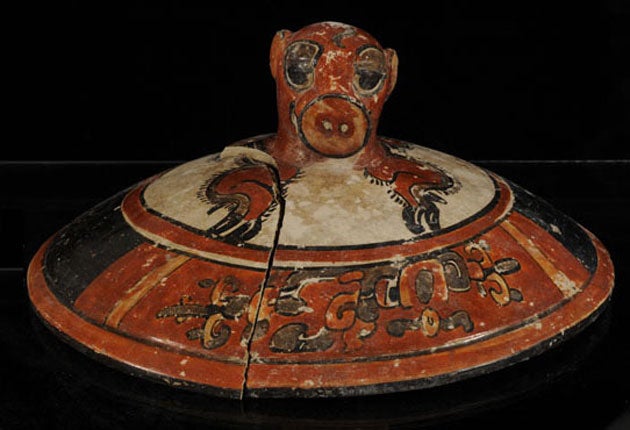Guatemalan tomb reveals evidence of child sacrifice

A team of American archaeologists excavating in the Guatamalan jungle beneath an ancient Maya pyramid have discovered a royal tomb, filled with colourful 1,600-year-old Mayan artefacts and the bones of as many as six children, possible victims of human sacrifice.
The archaeological team led by Stephen Houston, professor of anthropology at Brown University in Rhode Island, uncovered the tomb – which dates to between 350 and 400 AD – beneath the El Diablo pyramid in the city of El Zots in May, and announced their discovery to the public last week.
Houston said the first pointer to the tomb were grizzly deposits unearthed at a small temple where the team was digging, in front of a sprawling structure dedicated to the Maya sun god.
“When we sunk a pit into the small chamber of the temple, we hit almost immediately a series of ‘caches’ – blood-red bowls containing human fingers and teeth, all wrapped in some kind of organic substance that left an impression in the plaster,” said Houston. “We then dug through layer after layer of flat stones, alternating with mud, which probably is what kept the tomb so intact and airtight.”
After probing at a final layer of earth, a small black hole opened up, into which the team lowered a light bulb and immediately witnessed “an explosion of color in all directions – reds, greens, yellows.” The tomb was packed with carvings and ceramics, as well as organic material – wood, textiles, thin layers of painted stucco and cord – in a state of preservation unlike any Houston had witnessed before.
“When we opened the tomb, I poked my head in and there was still, to my astonishment, a smell of putrification and a chill that went to my bones. The chamber had been so well sealed, for over 1600 years, that no air and little water had entered.”
About six feet high, 12 feet long, and four feet wide, the tomb appears to have held an adult male between 50 and 60 years old at time of death. Houston believes that he was an important king known about only from hieroglyphic texts. “These items are artistic riches, extraordinarily preserved from a key time in Maya history. From the tomb’s position, time, richness, and repeated constructions atop the tomb, we believe this is very likely the founder of a dynasty.”
Also found buried in the tomb were the remains of as many as six children, some whole bodies and two skulls. Ranging in age from one to five years old, they were “probably sacrificed” in honour of the ruler. A “sacrificial blade” found in the tomb – which appears to have been used for cutting and grinding through bone or some other hard material – may have been gripped by the hand of the king. The blade’s surface seems to be covered with red organic residue. Though the substance still needs to be tested, “it doesn’t take too much imagination to think that this is blood,” Houston commented.
Much work remains to be done on the tomb and its contents, including a full scientific analysis of all of the human remains. “We’re still catching our breath after a very difficult, technical excavation,” said Houston. “Royal tombs are hugely dense with information and require years of study to understand. No other deposits come close.”
Maya People Knew about Prehistory: Aquatic Underworld based on Marine Fossils
Subscribe to Independent Premium to bookmark this article
Want to bookmark your favourite articles and stories to read or reference later? Start your Independent Premium subscription today.

Join our commenting forum
Join thought-provoking conversations, follow other Independent readers and see their replies